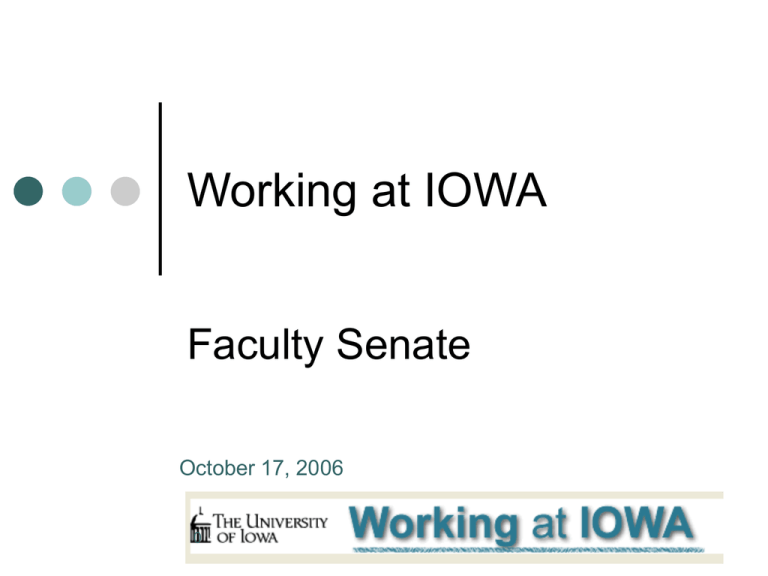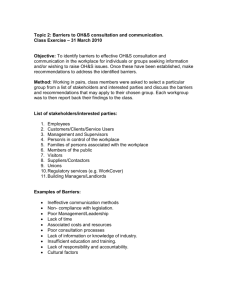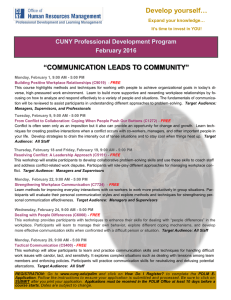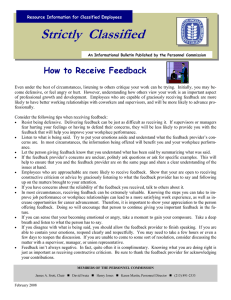Working at IOWA Faculty Senate October 17, 2006 0
advertisement

Working at IOWA Faculty Senate October 17, 2006 0 History and Objectives • • • Survey developed 2005-2006 Administered April 17-28, 2006 to faculty and staff Objectives o o Measure engagement among faculty and staff Improve the University’s effectiveness as an employer Optimize HR programs, policies and procedures Establish an “engagement” baseline o o 1 Respondents Of the 14,590 faculty and staff who received the survey, 6,217 responded for an overall return rate of 43%. • 32% Faculty • 48% P&S and MSE/C 39% Merit • 2 Survey Design • • • Identified engagement categories Selected demographics Organized survey statements according to “My job”, My workplace” and the “UI as an Employer” 3 Categories Each category has specific evaluative survey items • Engagement - the extent to which the University has captured the hearts and minds of faculty and staff (Hewitt, 2003) • Cooperation/Collaboration -examining how we work together • Supervisory Effectiveness - having quality and skilled managers • Communication - seeking input, sharing information and participating in decision-making • Confidence in Leadership Vision - having confidence that Leadership knows where it is going and how to get there successfully 4 Categories Each category has specific evaluative survey items • Commitment to Employee Well-Being - caring about faculty and staff well-being, development, diversity and recognition • Customer Focus - providing high quality, high value service to internal and external customers, which may include students, patients, vendors, colleagues and one another as co-workers • Flexibility - adapting to change and sensitive to continuous improvement • Overall satisfaction – believing the workplace is moving in a positive direction/feeling satisfied with the job 5 Demographics • • • • • • Organizational unit Position classification Years of Service Gender Ethnicity/race Age 6 Examining the Data • • • 6 point scale Interpreting the data according to position classification and demographics Looking for variations or meaningful differences 7 Process to Choose Priority Areas • • • Identified top 5 strengths and opportunities for improvement Looked at size of “neutral zone” Examined findings of “My Job”, “My Workplace” and the “UI as an Employer” 8 Strengths In general, faculty & staff agreed most with items: • • • I look for more effective ways to do my work. (99%) I know what is expected of me in my job. (95%) I understand how my job fits into the mission of the UI. (94%) 9 Strengths In general, faculty & staff agreed most with items: • • My workplace has a strong focus on providing excellent service. (90%) I have the basic resources I need to do my job. (90%) 10 Specific to Faculty Faculty agreed most with items: • • • I look for more effective ways to do my work. (99%) I know what is expected of me in my job. (94%) I have the authority to make decisions as defined by my job. (92%) 11 Specific to Faculty Faculty agreed most with items: I understand how my job fits into the overall mission of the UI. (91%) • The UI does a good job of informing faculty of policy changes. (87%) • 12 Opportunities for Improvement In general, faculty & staff most disagreed with items: • • • Poor performance is managed appropriately.(45%) I am kept informed of our workplace budget status. (38%) Work-related conflicts are constructively handled. (36%) 13 Opportunities for Improvement In general, faculty & staff most disagreed with items: • • Workloads are fairly distributed. (34%) I am confident there is a clear plan to strengthen the UI. (30%) 14 Specific to Faculty Faculty disagreed most with items: • • • I am confident there is a clear plan to strengthen the UI. (52%) Poor performance is managed appropriately. (49%) Overall, I think the UI is moving in a positive direction. (41%) 15 Specific to Faculty Faculty disagreed most with items: • • My workplace provides support to help faculty balance work and personal life responsibilities. (39%) Workloads are distributed fairly. (39%) 16 Category Analysis Cronbach’s Alpha .85 .86 Mean Engagement Cooperation/ Collaboration # of Items 5 6 4.6 4.4 Standard Deviation .94 .96 Supervisory Effectiveness 10 .93 4.3 1.07 Communication Confidence in Leadership 11 2 .89 .88 4.5 4.2 .85 1.09 Commitment to Employee Well-Being 7 .83 4.4 .84 Customer Focus Flexibility Overall Job Satisfaction Positive on Future 1 2 1 1 -.43 --- 4.9 5.0 4.7 4.3 1.07 .73 1.17 1.31 Category 17 Recommendations 1. Have top leadership (VP Group) make a statement about how people are the University's most important asset and encourage orgs/units to continuously recognize faculty and staff efforts. 2. Improve communication by supervisors/leaders regarding organizational priorities, performance expectations, budget and process improvement. 18 Recommendations 3. Involve supervisors, leaders, and staff in continuous improvement of business processes to address workload issues. 4. Provide opportunities to improve skills of supervisors and leaders in the areas of conflict resolution, workload distribution, and performance management. 5. Hold supervisors and leaders accountable for the management of conflict, workload, process improvement and poor performance 19 Recommendations 6. Encourage individual participation in performance reviews and goal discussions throughout the year. 7. Encourage and support departmental and collegiate recognition programs. 8. Encourage all of campus to recognize organizational successes and share that information. 20 Recommendations 9. Encourage all faculty and staff to continue to upgrade their skills and learning. 10. Work with supervisors/leaders to provide opportunities for all employees to attend and participate in University activities while maintaining appropriate staffing levels. 11. Provide administrative support and leadership to move responses from the neutral zone to the positive zone. 21 Disseminating the Data • • • Posting the report on the Working at IOWA website Scheduled meetings with Deans/Associate Deans/VPs and Senior HR Leadership Representatives Scheduled meetings with constituency groups 22 Colleges/Divisions: Acting on Results • • • • Integrate with existing activities and strategic plans. Use established work groups. Make it manageable. Request assistance from OE if needed. 23 Closing Thought or Questions 24



